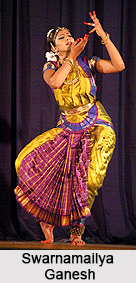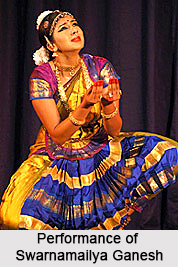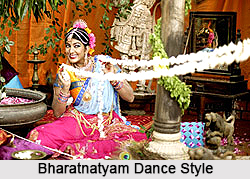 Swarnamalya`s approach to Nritta is neat, with clarity in stamping and precision in footwork. The sancharis for the Sahitya lines, though limited, were apt. Swarnamalya danced with vigour, especially from "Nannu Brova Neeku Bhaarama". -- The Hindu. In the year 1994, the News Times complemented Swarnamalya Ganesh as a promising star on the domain of Bharatanatyam. At the tender age of five, she was first initiated into Bharatanatyam under the guidance of Smt.K.J. Sarasa. She made her stage debut at the age of 12. In the field of dance, she has been creating a consecrated approach. She has chosen this as her central cohesive source of support and stability. Swarnamailya Ganesh`s passion for refinement and thirst for increasing her entire range of skills placed automatically her under the tutelage of Bhagavatula Sri.B. Seetharama Sharma of Kalapeetam. Under this significant guidance she received further grooming and also learnt Nattuvangam and carnatic vocal.
Swarnamalya`s approach to Nritta is neat, with clarity in stamping and precision in footwork. The sancharis for the Sahitya lines, though limited, were apt. Swarnamalya danced with vigour, especially from "Nannu Brova Neeku Bhaarama". -- The Hindu. In the year 1994, the News Times complemented Swarnamalya Ganesh as a promising star on the domain of Bharatanatyam. At the tender age of five, she was first initiated into Bharatanatyam under the guidance of Smt.K.J. Sarasa. She made her stage debut at the age of 12. In the field of dance, she has been creating a consecrated approach. She has chosen this as her central cohesive source of support and stability. Swarnamailya Ganesh`s passion for refinement and thirst for increasing her entire range of skills placed automatically her under the tutelage of Bhagavatula Sri.B. Seetharama Sharma of Kalapeetam. Under this significant guidance she received further grooming and also learnt Nattuvangam and carnatic vocal.
Swarnamailya Ganesh, from the veteran musicologist Sri.T.S.Parthasarathy, has received good direction on the aspects of theory of dance and contents of lyrics. During the season, she has given performances in all possible leading Sabhas. She has the honor of performing on important occasions like Kanchi Paramcharya`s Centenary Celebrations, India`s Golden Jubilee, Bharathiar Day, Swati Tirunal Day etc. The Bharat Kalachar described her as the young achiever when she was conferred the prestigious title of Yuva Kala Bharathi. By awarding "Miss. Lakshmi Viswanathan Endowment Award", Sri.Krishna Gana Sabha recognized her talent and merit. The award was given to her for the best demonstration of Tanjore Quartette Varnam of the year 1998.  At Hyderabad, the Nrityotsavam`99 of the South Indian Cultural Association took place, where she also performed. She was paid persuasive tributes by the critics of Hyderabad who heralded her as one of the finest and most mature performers of Bharatanatyam.
At Hyderabad, the Nrityotsavam`99 of the South Indian Cultural Association took place, where she also performed. She was paid persuasive tributes by the critics of Hyderabad who heralded her as one of the finest and most mature performers of Bharatanatyam.
As a humble oblation, she has choreographed and confronted thematic dance features `Vande Mataram`. It was a dance tribute to Mother India and `Yadumahi Nindroy` to the Divine Mother of the Universe. She is presently serving on the Executive Committee of the Association of Bharatanatyam Artistes of India (ABHAI) and leads the editorial Board of its News Letter. Swarnamailya Ganesh due to her other cultural talents and activities, is brought down as a popular anchor person and TV Star on the Satellite Channels Sun and Vijay.
Swarnamalya Ganesh is regarded as one among the first of all of the new generation of dancers of her native country India. A compelling charm can always be viewed in Swarnamalya`s dance. Competence in technique, flair in rhythm and eloquence in expressions are the attributes that are reflected with her performance. Her dance is best identified as an experience of dynamic beauty. She interpenetrates the style with her own accomplishing personality. At Bharat Kalachar Natya Utsav, she gave an astonishing and captivating recital. Swarnamalya embodied the rare occurrence of talent beauty and opportunity.
 Swarnamalya means "A golden garland". With artistic inflammation and decreed to shoot to fame putting on multi various avatars, a golden girl, Swarnamalya was born. She is a dancer, an anchor, an actress, all with academe in excellence. She truly regarded as `The Madonna of Chennai` for her assortment of talents, search of knowledge and artistic pursuits. She is a graduate from MOP Vaishnav College. She has done her MBA, from Symbiosis and has also completed a PG Diploma in Acting and Direction from Sanjose State University, CA, USA. At present she is pursuing her Masters in Bharatanatyam from the Madras University. On certain aspects of dance, she is profoundly involved in her search and research in which she would be pursuing her doctoral degree. She has also learnt Odissi from Guru Kshama Rao, who is a student of Guru Kelucharan Mahopatraji.
Swarnamalya means "A golden garland". With artistic inflammation and decreed to shoot to fame putting on multi various avatars, a golden girl, Swarnamalya was born. She is a dancer, an anchor, an actress, all with academe in excellence. She truly regarded as `The Madonna of Chennai` for her assortment of talents, search of knowledge and artistic pursuits. She is a graduate from MOP Vaishnav College. She has done her MBA, from Symbiosis and has also completed a PG Diploma in Acting and Direction from Sanjose State University, CA, USA. At present she is pursuing her Masters in Bharatanatyam from the Madras University. On certain aspects of dance, she is profoundly involved in her search and research in which she would be pursuing her doctoral degree. She has also learnt Odissi from Guru Kshama Rao, who is a student of Guru Kelucharan Mahopatraji.
At the age of 17 years, the Bharat Kalachar awarded the `Yuvakala Bharati` to Swarnamalya Ganesh. In the history of Bharat Kalachar, she has been the youngest recipient who was picked out by a Committee comprising of Sri Lalgudi Jayaraman, Dr.Padma Subramaniyam, Smt Chitra Visweswaran, Smt Sudharani Raghupathy, Sri V.P.Dhananjayan, etc. In the year 1998, for the best varnam presentation in the December festival, she was awarded the `Lakshmi Viswanathan Endowment Prize` from Sri Krishna Gana Sabha. The Tamilnadu Iyal Isai Nataka Mandram conferred her the Scholarship of them. From all the senior most dance critics, she has received gushing reviews in all leading newspapers and magazines. She has hosted a dance based TV programme in Srilanka`s Sakthi TV. She has been the Founder Trustee and Director of RANGA MANDIRA. To promote Bharatanatyam and other performing arts this Trust was founded.



















